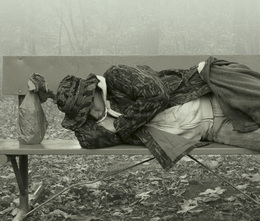
At last count, on a below-freezing day in January, there were 17 percent more homeless people in Bucks County than there were two years ago: as many as 572 people living outdoors or in shelters, according to the county’s annual tally of those without homes.
Unfortunately, the number is misleading.
Often, the suburban homeless don’t want to be found so they camp out in the woods or sleep in cars or train stations. Also undercounted are those living with other families or in hotels, according to Melissa Mantz, development officer of the Bucks County Housing Group, a Wrightstown-based organization that provides affordable housing and related social services to those in need. The group operates five shelters in Penndel, Morrisville, Quakertown and Doylestown, as well as St. Mary’s in Langhorne and 80 rental units, assisting 140 adults and 240 children.
Because homelessness is more often a temporary circumstance, some advocates measure the number of people who experience homelessness over time, not the number of so-called “homeless people.”
“It is really hard to tell who is homeless in Bucks County,” says Mantz says. “They may live in their cars in the summer or even now in parks. They are invisible. But they are you and me.”
Although most people tend to think of the homeless as disheveled older men with dirty beards and rags for clothing, living on the streets of urban centers, the economic downturn has altered and expanded the traditional definition. Mantz remembers a 17-year-old with a baby she met when she first started working at the Doylestown shelter. The girl got her life together and moved out, then things fell apart and she wound up moving back. Eventually, Mantz got her into a housing voucher program and on the right path.
“Then there was another woman at the Doylestown shelter for three months, who moved on and [now] sends us a check each year,” she says. “The goal is to get people where they need to be.”
“Unless there is some type of subsidized housing vouchers”—Section 8 was closed in Bucks County for 30 months—“mothers with children have nowhere to go,” Mantz says.
“Mothers want to keep their kids, and moms who end up in that position are pretty resourceful. Most of them really want to make things different for their kids.”
Factors such as addiction, abuse, prison and mental illness most frequently lead to homelessness, but over the past two decades, the rise in homelessness can be tied to two trends: a growing shortage of affordable rental housing and an increase in poverty. The result? Families stay much longer in the shelter system—on average, between eight and 14 months, according to Mantz.
“People are suffering, especially those at the lower end of the socio-economic scale,” she says. But nowadays, the formerly affluent are joining them. The three food pantries the Bucks County Housing Group operates are a good barometer of homelessness. “We noticed well before the economy began to falter that people were coming to the food pantries who never did before.
“I see a lot of food-pantry families that were counting on two six-figure incomes, and [now] the second person can’t find a job,” she adds. “By the end of the month, after they pay the mortgage or other bills, they don’t have food.”
She also saw a 13 percent increase among elderly people using the pantries—“and that’s only the ones seeking it out. They come from a time when [asking for help] would be highly difficult for them to do.”
Even so, a person in need who does have food and shelter can struggle in a rural or suburban setting where there is no public transportation, according to Mantz: “If you don’t have a car and you live in the Milford Square shelter and need to see a case worker in Bristol, you need to really work to get a ride 50 miles round trip.”
“What makes us unique is that we provide transportation,” Martin says. “We need to with Bucks County being so vast.” But transportation insurance and diesel fuel are expensive, and AHTN has to move all of its bedding, shelving, files and food each month to a new church.
Every January, the county sends out employees and volunteers to count the homeless who live outdoors. One 51-year-old woman living in the woods in Doylestown, according to a report in the Intelligencer, has been homeless for almost 20 years. She grew up in Chalfont, graduated from Central Bucks and lived mostly in the area, but bad experiences in shelters left her more content to live outdoors. The preliminary “unsheltered” count this year was 29, living in wooded areas or multi-tent camps, such as the one behind a Bristol shopping center where a homeless daughter allegedly murdered her mother for refusing to move to Tennessee with her.
“We have many, many repeat guests,” Martin says. “Many of them have the same story. They went through their savings. … Our oldest guest was 74 years old this year, and we helped him get on a waiting list for Red Cross.”
Martin is excited about the connections made with other organizations in Bucks County. AHTN wants to open satellites in other sections of the county and is willing to share its knowledge and procedures.
“When we get our folks, they are the chronic homeless,” Martin says. “We get calls every day from people who are in need.”
Both the housing group and AHTN need donations of cash and vehicles, but AHTN also needs volunteers: grant writers, dentists, eye doctors, people with social-service skills to mentor people, professionals to address addictions, etc.
“And,” Martin says, “we’d love a permanent home.”


